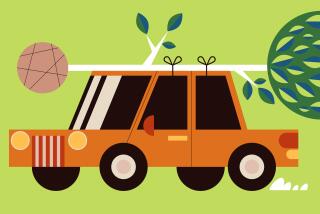Where to find California’s moon trees, grown from seeds taken aboard an Apollo mission
- Share via
You can thank Stuart Roosa for what have become known as America’s moon trees. The Apollo 14 astronaut and former U.S. Forest Service smokejumper blasted off for the moon in 1971 with hundreds of seeds from different species of trees among his possessions. Those seeds were brought back, germinated on Earth, and the saplings were given away to communities across the U.S. during the 1976 bicentennial.
Moon trees planted in California, coast redwoods all, still stand. One of the Sequoia sempervirens can be found in downtown Monterey. “There’s a plaque by the tree that tells the story,” said Rachel Dinbokowitz of the Monterey County Convention & Visitors Bureau. “It was planted in July 1976 right near Colton Hall.”
There’s also a moon tree at the north entrance to the state capitol in Sacramento, two at Tilden Nature Area in Berkeley, one at Mission Plaza in San Luis Obsipo, three at Humboldt State University in Arcata, and at least one at a Forest Service site in Lockeford.
Aside from coast redwoods, Roosa brought seeds for loblolly pines from the South, Douglas fir from the Northwest, and sycamores, which grow all over the country but especially in the Northeast and the Midwest. Exactly how many moon trees still stand is anyone’s guess because records weren’t kept of where the saplings were distributed.
That’s where NASA archivist David R. Williams comes in. He took an interest in finding the moon trees in 1996 after receiving an inquiry about a moon tree from a teacher in Indiana. Since then, Williams brought the whereabouts of Roosa’s trees — as many as he could find and authenticate — to the internet. He also asked communities with moon trees to contact him to add to the archive.
“It is the only thing like this that I know of,” he said of Roosa’s actions. “It was kind of brilliant.” Brilliant in that Roosa left a lunar legacy with something as earthly as a tree for generations to enjoy, a reminder of the enthusiasm of America’s space program.
Roosa, a former Air Force fighter pilot, was the command module pilot for Apollo 14, meaning he circled the moon but didn’t walk on it.
The seeds in space were “part scientific experiment, part public relations venture,” purportedly testing how microgravity could affect plants, according to National Geographic.
Williams’ list of moon trees identifies about 80 current or former sites, including a sycamore moon tree at the Goddard Space Flight Center in Greenbelt, Md. The loblolly pine planted at the White House has since died, according to Williams’ records.
Roosa died in 1994 at age 61. His children have continued to support his moon tree legacy, planting a second-generation sycamore moon tree dedicated to the astronaut in 2005 at Arlington National Cemetery in Virginia. “The whole Roosa family was there,” Williams said.
More to Read
Sign up for The Wild
We’ll help you find the best places to hike, bike and run, as well as the perfect silent spots for meditation and yoga.
You may occasionally receive promotional content from the Los Angeles Times.







